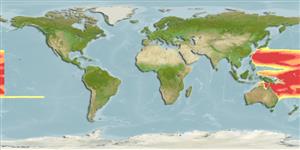Common names from other countries
>
Stomiiformes (Lightfishes and dragonfishes) >
Stomiidae (Barbeled dragonfishes) > Melanostomiinae
Etymology: Eustomias: Greek, eu = good + Greek, stoma = mouth (Ref. 45335).
Environment: milieu / climate zone / depth range / distribution range
Ökologie
seewasser bathypelagisch; tiefenbereich 0 - 415 m (Ref. 11333). Deep-water
Western Central Pacific: Queensland, Australia.
Size / Gewicht / Alter
Maturity: Lm ? range ? - ? cm
Max length : 15.8 cm SL Männchen/unbestimmt; (Ref. 11333); 9.7 cm SL (female)
A single, ovoid terminal bulb 1-1.2% SL. Barbel length short to intermediate 32-60% SL. Short terminal filaments 9 or more of various sizes; shortest filaments often bulblet-tipped; longer ones with bulblets and inclusions of various sizes and shapes; 1 filament thicker and longer than others, not forked, with 1 or more long inclusions filling most of its distal end. Axis of stem lightly or not pigmented. A dark spot usually at the base of the bulb. External chevron-shaped or roundish striated areas unpigmented. Middorsal paired spots between occiput and dorsal-fin origin 7 (Ref. 11333).
Life cycle and mating behavior
Maturities | Fortpflanzung | Spawnings | Egg(s) | Fecundities | Larven
Paxton, J.R., D.F. Hoese, G.R. Allen and J.E. Hanley, 1989. Pisces. Petromyzontidae to Carangidae. Zoological Catalogue of Australia, Vol. 7. Australian Government Publishing Service, Canberra, 665 p. (Ref. 7300)
IUCN Rote Liste Status (Ref. 130435)
CITES (Ref. 128078)
Not Evaluated
Bedrohung für Menschen
Harmless
Nutzung durch Menschen
Tools
Zusatzinformationen
Download XML
Internet Quellen
Estimates based on models
Preferred temperature (Ref.
115969): 16.2 - 27.8, mean 26.1 (based on 18 cells).
Phylogenetic diversity index (Ref.
82804): PD
50 = 0.5000 [Uniqueness, from 0.5 = low to 2.0 = high].
Bayesian length-weight: a=0.00302 (0.00117 - 0.00783), b=3.12 (2.89 - 3.35), in cm Total Length, based on LWR estimates for this (Sub)family-body shape (Ref.
93245).
Trophic level (Ref.
69278): 4.3 ±0.8 se; based on size and trophs of closest relatives
Widerstandsfähigkeit (Ref.
120179): mittel, Verdopplung der Population dauert 1,4 - 4,4 Jahre. (Assuming tmax>3).
Fishing Vulnerability (Ref.
59153): Low vulnerability (10 of 100).
